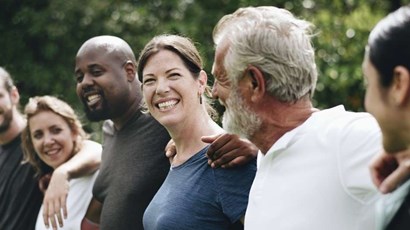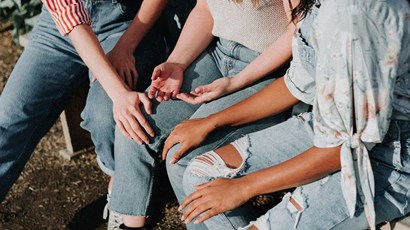Preventing Skin Cancer
Some skin cancers can be partly prevented by protecting yourself from the sun, not smoking, and generally taking care of your health. Some kinds of skin cancer can't be prevented however, because they are caused by something going wrong in your genes: this is beyond your control.
This leaflet gives tips on how to prevent skin cancer.
There are three basic types of skin cancer: basal cell carcinomas, squamous cell carcinomas, and melanoma. You can read about basal cell carcinomas and squamous cell carcinomas in the separate leaflet called Non-melanoma Skin Cancer. You can read more about melanoma in the separate leaflet called Melanoma Skin Cancer.
Sun and skin damage
The main type of skin cancer that is caused by too much sunlight is basal cell carcinoma. To a lesser extent, melanoma is also caused by too much sun exposure.
Too much exposure to sunlight is harmful and can damage the skin. Some of this damage is short-term (temporary), such as sunburn. However, allowing your skin to burn can lead to future problems, such as skin cancer, due to long-term skin damage.
Getting sunburnt is a warning sign that you are putting yourself at risk. Skin cells that are damaged are at greater risk of becoming abnormal and cancerous. It is particularly harmful for children to get sunburnt: this has been proven to be related to a higher chance of getting melanoma later in life compared to someone who hasn't been sunburnt.
Melanin is the coloured pigment in our skins. When skin is exposed to sunlight, more melanin is produced to help protect the skin against the UV rays. This makes the skin darker - what people refer to as a suntan. Although melanin stops your skin burning so easily, it does not prevent the harmful effects of UV rays.
Sun damage can also cause other skin problems to develop. For example, it can cause premature skin ageing, such as wrinkles and loss of elasticity. It can also cause non-cancerous growths on the skin, such as solar keratoses (also called actinic keratoses; these are further discussed in the separate leaflet called Actinic Keratosis).
Should you wear sunscreen even when it's cloudy?
We often only think about sun protection when it's sunny outside. But you still need to take ste...
Who is at risk of skin cancer?
People of all ages should protect their skin, but it is even more vital to protect children. Although skin cancer is rare in children, the amount of sun exposure during childhood is thought to increase the risk of developing skin cancer in adult life. Children who have had episodes of sunburn are more likely to develop skin cancers in later life. The skin of children is more delicate and more prone to damage. Therefore, take extra care with children. Babies can be exposed to the sun, but probably for less time than children.
If you have pale skin, red or fair hair, and freckles, you have the type of skin which burns most easily. This puts you at increased risk of sun-related skin damage and you should take extra care to protect your skin - NEVER allow yourself to burn. If you have pale skin, you do not have as much protective melanin. Skin cancers, especially melanoma, are less common in non-white skin types. However, they can still occur and sun protection is still important even if you have dark skin.
How can I protect skin from the sun?
Avoid the sun as much as possible when the sun is strong
If it is very hot and sunny, wherever you live, stay in the shade or indoors as much as possible between 11 am and 3 pm in the summer months (May to September). This applies all year round in hotter countries nearer to the equator. This middle time of the day is when the sun's rays are at their strongest. Trees, umbrellas and canopies can all provide good shade.
Cover up
Cover up the body as much as possible when you are out in strong sunshine:
- Wear wide-brimmed hats with a brim that goes all around the hat to protect the face and neck. These are the areas most commonly affected by sun damage. Men, in particular, seem most likely to develop skin cancers on their necks, shoulders and backs (women tend to get skin cancers more on their legs and arms). Baseball caps are not as effective, as they shade the face but not the neck, lower face and ears (unless you buy one with a cotton neck protector). Young children should wear hats with neck protectors too.
- Wear loose baggy T-shirts (or even better - long-sleeved tops) and baggy shorts. The material should be tightly woven to block out sunlight.
- Wear wrap-around sunglasses (your eyes can get sun damage too). Make sure the sunglasses conform to the European Standard, indicated by the CE mark (or equivalent) and are labelled as providing protection against UV light.
Use a high-factor sunscreen liberally
You should apply sunscreen of at least sun protection factor (SPF) 15 (SPF 30 for children or people with pale skin) which also has high UVA protection. SPF gives a guide to how much sun protection is afforded by a particular sunscreen. The higher the SPF, the greater the protection. The SPF label shows the protection against UVB which leads to sunburn and the damage that can cause skin cancer.
It is also important that your high SPF sunscreen should also have a high level of UVA protection. UVA can cause ageing of the skin and also the damage that can cause skin cancer. Sunscreens with high UVA protection will have a high number of stars (these range from 0 to 5).
Be sure to cover areas which are sometimes missed, such as the lips, ears, around the eyes, neck, scalp (particularly if you are bald or have thinning hair), backs of hands and tops of feet.
You should not think of sunscreen as an alternative to avoiding the sun or covering up. It is used in addition. Sunscreens should not be used to allow you to remain in the sun for longer - use them only to give yourself greater protection. No sunscreen is 100% effective and so it provides less protection than clothes or shade. Ideally:
- Apply sunscreen 20-30 minutes before going out into the sun (it takes a short time to soak into the skin and work).
- Apply enough sunscreen to cover the skin that will be exposed. For most people this is the equivalent of two teaspoons of cream for the head, neck and arms. For the whole body while wearing a swimming suit, this would be around two tablespoons.
- Re-apply frequently, at least every two hours, and always after swimming, towelling yourself dry or excessive sweating (even those that are labelled waterproof).
- Re-apply to children even more often.
More tips for protecting skin
- Sunscreens with an SPF of less than 15 do not give much protection. Always use factor 15 or above. Consider a much higher factor if you are on holiday in a very hot country.
- Sunscreens can go off and not work after a time. Therefore, do not use out-of-date sunscreen (see the use by date on the bottle). Most have a shelf life of 2-3 years.
- Being kept in the sun can cause deterioration of the active protective ingredients in sunscreen. Be wary of buying bottles of sunscreen that have been kept on a shelf in direct sunlight or outside in hot countries. Try to keep your sunscreen somewhere cool and shaded.
- Some experts think that the increased use of sunscreen lotions and creams may give a false sense of security. This may encourage people to go into the sun more and, as a result, cause an increase in your risk of developing skin cancers. It has to be emphasised that sunscreen only partially protects your skin. Using sunscreen does not mean that you can sunbathe for long periods without harm. If you tan then you have done some damage to your skin.
- Reflected light can damage too. On sunny days, even if you are in the shade, sun can reflect on to your skin. Sand, water, concrete and snow are strong reflectors of sunlight.
- Wet clothes let through more UV light than dry clothes. Take spare clothes with you if you expect to get wet.
- You can burn in the water. Even if you are swimming in a pool or snorkelling in the sea, you can still get burnt.
- Clouds may give a false sense of security. Most of the UV radiation from sunshine still comes through thin cloud. Thick cloud provides some protection, but you still need protection when there is thin cloud.
- Many clothes worn in hot weather (such as thin shirts) actually allow a lot of sunlight through. You should wear tightly-woven clothes to protect from the sun's rays. If you can see light through a fabric then damaging UV rays can get through too.
- The sun's rays are more powerful at higher altitudes. It may be cooler up a mountain but you will need more skin protection.
- Artificial tanning from sun-ray lamps and sunbeds is just as damaging as sunshine - so avoid them. Studies have shown that sunbeds increase the risk of all types of skin cancer.
- It is not the heat that does the damage but the UV radiation in sunlight, which is present all year. You can get a lot of UV exposure doing winter sports, such as skiing, as it is often done in sunny weather and at high altitudes. In particular, remember ice and snow reflect a lot of sunlight. So, you should wear a hat, sunscreen, lip balm containing an SPF, and sunglasses.
The Solar Ultraviolet Index
In the UK, the Met Office provides information called the Solar UV Index with their weather forecasts. The index is given as a figure in a triangle over the maps they use when giving forecasts. Basically, the higher the index (from 1 to 10), the greater the risk from the sun, and the more care you should take of your skin when outside. See the link in 'Further Reading and References' below.
Sunshine and vitamin D
Vitamin D is vital for good health. Vitamin D is made in the skin with the help of sunlight. Sunlight is actually the main source of vitamin D, as there is very little found in the foods that we eat.
This means that to be healthy you need a certain amount of sun exposure. There is concern that some people may go to the extreme of avoiding the sun altogether and then become deficient in vitamin D. The aim is to enjoy the sun sensibly, so as to make enough vitamin D, whilst not increasing the risk of skin cancer.
It is estimated that, to prevent deficiency of vitamin D, we need 2-3 sun exposures per week in the summer months (May to September). Each exposure should last 20-30 minutes and be to bare arms and face. Short frequent periods of time in the sun are much more beneficial than long periods of time. It needs to be exposure to direct sunlight and not through a window. It is not the same as suntanning and sunburn should be avoided at all costs. (See the separate leaflet called Vitamin D Deficiency for more information.)
The information above mainly applies to the skin cancer types basal cell carcinomas and, to a lesser extent, melanoma.
How to prevent squamous cell carcinomas
Squamous cell carcinomas have a number of causes, only one of which is sunlight. Other causes are:
- Smoking.
- Heavy alcohol use.
- Being on medicines that suppress your immune system.
- Having another serious illness that affects the immune system, like HIV.
In terms of preventing squamous cell carcinomas, you should not smoke and only drink in moderation. If you are on medications that suppress the immune system and you notice a growth on your skin, you should get it checked by a doctor as soon as possible. This is particularly true if you have had an organ transplant and are on anti-rejection medication.
How to prevent melanoma
Certainly at least half of cases of melanoma are caused by too much sun, or by being sunburnt earlier in life. So the advice, above, of avoiding too much sun, is all relevant. But many cases of melanoma occur on places which don't get much sun and also occur in young people who haven't ever had much sun exposure.
These types of melanoma are caused by a genetic mutation and are beyond your control. If you do develop melanoma it may have been nothing to do with your lifestyle: don't feel guilty.
Further reading and references
UV forecast; Met Office







